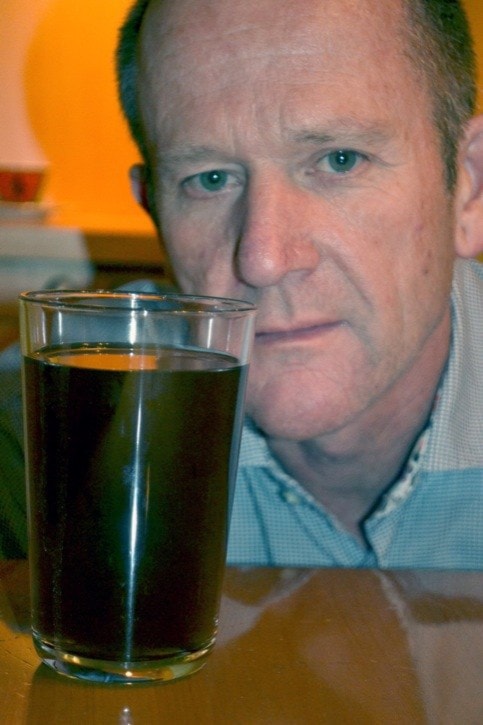White Rock’s Rolf Effertz is seeing “through a glass, darkly” – quite literally – when he looks at the quality of water coming out of his taps.
A glass full of brown water – which, when stirred to disturb the thick layer of sediment at the bottom, becomes even darker – is Effertz’ ‘exhibit A’ for his concerns about the quality of water delivered by the city’s utility.
It represents the residue he found at the bottom of a five-gallon (18.9-litre) plastic jug that he filled with city water and allowed to sit for four days.
“That was what was left when I emptied it,” he said, pointing to a glass sitting in his Bishop Road home. “Not to mention the particulate that went out with the rest of the water.
“I needed to get the residue off the bottom of the bottle, so I swirled bleach around it and emptied the bleach and the residue into the glass. That’s what came out with the bleach – if it had just been bleach in there, it would have been clear.”
White Rock communications manager Farnaz Farrokhi told Peace Arch News Tuesday that city operations staff would be going to Effertz’s home that day to investigate the cause of the murky water.
At press time, no further information was known, although Farrokhi said the operations team had ruled out the possibility that the residue was a result of preliminary work for the annual water main flushing, scheduled for Nov. 7.
To Effertz, the residue indicates that something is seriously wrong with White Rock’s water quality since the city introduced chlorine into water in early October.
The city has informed residents that the introduction of chlorine, in combination with naturally-occurring manganese, might result in “cloudy” water.
“Although the water esthetics may change, the city’s water is still safe to drink,” the city has stated in a press release heralding the phasing-in of chlorination.
Effertz, who has since purchased and installed a reverse-ionization water filtering unit in his kitchen, has his doubts.
“It may be safe to drink – that could be debatable – but it’s anything but clean,” he said.
“I believe that every citizen of Canada has the right to drink water that is 100 per cent safe and clean.”
For Effertz, the residue is only confirmation of a jaundiced view of the water quality he’s had since chlorination was introduced – and his unwillingness to drink the water ever since.
He joked that a new city slogan for White Rock water should be “this mud’s for you.”
He said that the water he is receiving is perceptibly discoloured from the tap, even without being allowed to sit several days.
“Soon after the city introduced chlorination, my wife and I were having coffee and we looked at each other and said this tastes terrible.”
He installed a filtration unit soon after, he said.
“What else could I do?”
Effertz said he is not out to grind any axes against the city – “that’s not the case at all,” he said – but he is concerned about what the murky water could mean about the safety of water throughout the system.
“We drink it, we cook with it, we wash and bathe with it, we give it to our kids and animals.”
But as someone used to dealing with chemicals – he’s president of a Richmond company that manufactures anti-friction lubricants – he said he’s aware of studies that chlorination can cause problems in loosening scales of material that have gathered in aging infrastructure.
And while he’s willing to wait for results of city tests to find out the cause, he questions whether “it’s time for the city to raise the white flag and start the process of tapping into Metro Vancouver’s water system.”
